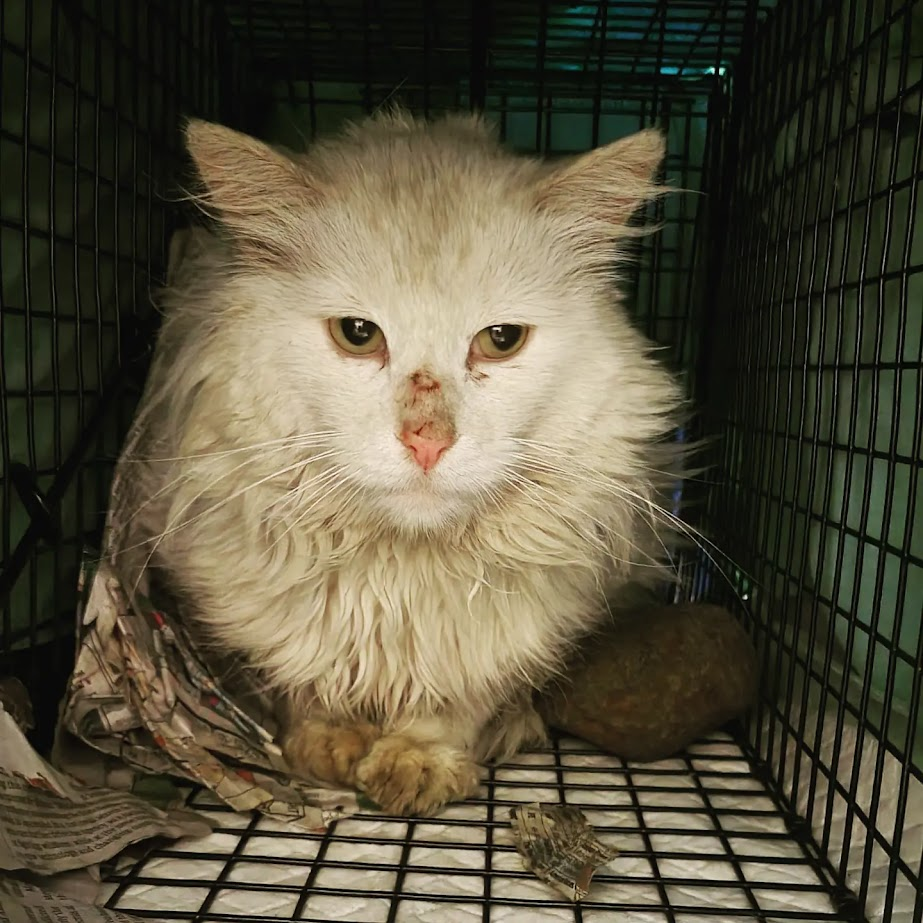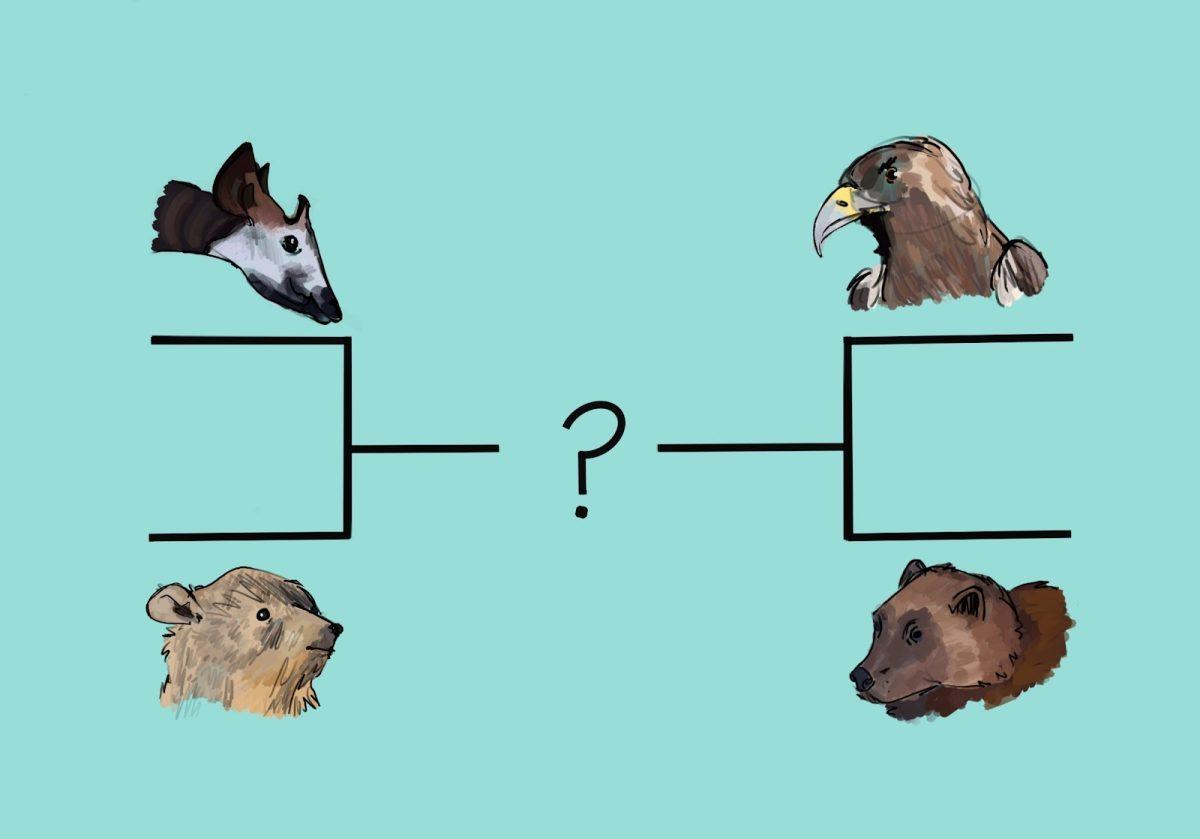
An Okapi, a Rock Hyrax, a Golden Eagle, and a Wolverine all advanced to the final four of March Mammal Madness. March Mammal Madness is a yearly tournament inspired by the NCAA March Madness. Illustration by Finch Hallstrom.
Hardcore college basketball enthusiasts will be familiar with the concept of March (Basketball) Madness, an annual competition to determine the fiercest examples of basketball prowess in college athletics. These athletes compete in a bracket-style tournament, with the champions defeating their opponent in every match over multiple rounds of play. March Mammal Madness follows a similar structure, with slightly more research and problem solving skills employed to execute such a large scale event.
Months before the battles begin in March, scientists, conservationists, librarians, and educators assemble to choose 35 unique species, with varying habitats, skills, sizes, and speeds, to compete in the tournament. Although the name of the tournament suggests all competitors will be mammals, for the past several years one side of the bracket has included a diverse range of organisms. “By showcasing species across animals, and sometimes beyond animals, we are able to talk about a wide variety of ecosystems roles, adaptations, and some really cool natural history,” explains Katie Hinde, founding director of March Mammal Madness, in an “Inside the Tournament” informational YouTube video.
The tournament organizers use information about each organism’s traits including their weaponry, armor, fighting style, temperament and motivation, speed, and physiology as well as their specific skills to calculate the probability of different outcomes in a battle. A random number generator is then used to determine the outcome of the match based on the probabilities calculated. Once the outcomes of the battles are known, the team of scientists and educators use detailed and thorough research to craft a science based story that supports the predetermined outcome. “Sometimes the outcome is improbable,” says Hinde, “but the story is always anchored to evidence.”
The tournament is hosted virtually, with the library website for Arizona State University serving as the official location for tournament resources, and the battle results are live tweeted on Twitter. However, March Mammal Madness doesn’t just reveal the outcome of a fight, they introduce each opponent with facts about their habitat, skills, behavior, and adaptations before launching into a tense play by play of each battle.
In the first four rounds of the tournament, the battle location is determined by the preferred habitat of the higher ranked combatant. For example, this year the Striped Dolphin faced off against the lower seeded Chequered Elephant Shrew, allowing their battle to take place in the ocean instead of the forests of Central and Southeast Africa where the shrew resides. Once the tournament progresses to the Elite Trait round (basketball fans might know this round by the title ‘Elite Eight’), the battle location is determined at random among four different ecosystems, which often changes the probabilities of the outcome before it is generated.
According to Hinde, the seeding, or ranking of each animal, is loosely determined by the animal’s bodyweight, with predators “punching above their weight” to account for their adaptation for predation.
This year, Anali Perry, Head of Open Science and Scholarly Communication at Arizona State University, is the primary library contact for March Mammal Madness. She is assisted by René Tanner, Hanice Hermer, and Mimmo Bonanni. As a team, they determined the four sections of this year’s bracket: Mighty Stripes, Itty Bitty Comeback City, Animal Engineers, and Dad Bods (organisms where the male raises the young). After two weeks to research and fill out a bracket, participants had the opportunity to get their first point of the year with the wildcard match: The Bumblebee Bat versus the Shrew Mole.
In order to prepare for the championship on April 5, the animals of March Mammal Madness have faced many challenges, including a few upsets. The introduction of additional players as interference allows for the underdogs to claim a win. During round one of the Dad Bods bracket, the Dyak Fruit Bat (seed 10) outlasted the Greater Flamingo (seed seven) with the distraction of a Yellow-Legged Gull. In round one’s Mighty Stripes category, the Highland Streaked Tenrec (seed 11) outlived the Wildcat (seed six), as it was attacked by a large domesticated but feral cat, one of the Scottish Wildcat’s biggest threats, allowing the Tenrec to outlast the Wildcat. Most excitingly, in round two of Itty Bitty Comeback City, the grasshopper mouse (seed nine) outlasts the Otter while in the Otter’s marine habitat.
In addition to being jam-packed with action, March Mammal Madness is an entertaining way to teach about the traits and adaptations of fascinating organisms. Franklin Biology teacher Dr. Sahnzi Moyers participates in March Mammal Madness with her students, and this year she encouraged other science teachers in the building to participate as well. “It’s a fun way to get students excited about some really amazing and diverse animals and their adaptations,” she says. “Plus, a little competition can be fun!” Dr. Moyers uses the tournament as a teaching mechanism as well as an opportunity for lighthearted competition. “For the most part, it’s really fun to watch students’ competitive nature come out and watch them get so excited while researching biology. While the combat piece is fairly silly, it’s an exercise in making predictions based on the information you have about these animals and their adaptations!”
Over the years, March Mammal Madness has grown significantly. According to Hinde, the tournament began as a single bracket and a blog post, but it has grown year after year in many ways including “Expanding the educational resources that are provided, the different mechanisms of sharing results with players, and systematically mak[ing] the tournament more fun, more informative, and more inclusive.”
After a month of surprise twists, fascinating animal facts, and action packed battles, the tournament ended with the championship match on April 5. The results can be found on the Arizona State University library website. No matter if your bracket winner matches the official tournament results or if the champion you chose lost round one, March Mammal Madness brings together a community to celebrate the diversity of fascinating creatures inhabiting Earth. It is, after all, like the official motto says: “If you’re learning, you’re winning!”


































